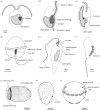Evolution of phototaxis
- PMID: 19720645
- PMCID: PMC2781859
- DOI: 10.1098/rstb.2009.0072
Evolution of phototaxis
Abstract
Phototaxis in the broadest sense means positive or negative displacement along a light gradient or vector. Prokaryotes most often use a biased random walk strategy, employing type I sensory rhodopsin photoreceptors and two-component signalling to regulate flagellar reversal. This strategy only allows phototaxis along steep light gradients, as found in microbial mats or sediments. Some filamentous cyanobacteria evolved the ability to steer towards a light vector. Even these cyanobacteria, however, can only navigate in two dimensions, gliding on a surface. In contrast, eukaryotes evolved the capacity to follow a light vector in three dimensions in open water. This strategy requires a polarized organism with a stable form, helical swimming with cilia and a shading or focusing body adjacent to a light sensor to allow for discrimination of light direction. Such arrangement and the ability of three-dimensional phototactic navigation evolved at least eight times independently in eukaryotes. The origin of three-dimensional phototaxis often followed a transition from a benthic to a pelagic lifestyle and the acquisition of chloroplasts either via primary or secondary endosymbiosis. Based on our understanding of the mechanism of phototaxis in single-celled eukaryotes and animal larvae, it is possible to define a series of elementary evolutionary steps, each of potential selective advantage, which can lead to pelagic phototactic navigation. We can conclude that it is relatively easy to evolve phototaxis once cell polarity, ciliary swimming and a stable cell shape are present.
Figures


References
-
- Adamska M., Degnan S. M., Green K. M., Adamski M., Craigie A., Larroux C., Degnan B. M.2007Wnt and TGF-beta expression in the sponge Amphimedon queenslandica and the origin of metazoan embryonic patterning. PLoS ONE 2, e1031 (doi:10.1371/journal.pone.0001031) - DOI - PMC - PubMed
-
- Adl S. M., et al. 2005The new higher level classification of eukaryotes with emphasis on the taxonomy of protists. J. Eukaryot. Microbiol. 52, 399–451 (doi:10.1111/j.1550-7408.2005.00053.x) - DOI - PubMed
-
- Amon J. P., French K. H.2004Photoresponses of the marine protist Ulkenia sp. zoospores to ambient, artificial and bioluminescence light. Mycologia 96, 463–469 (doi:10.2307/3762166) - DOI - PubMed
-
- Amon J. P., Perkins F. O.1968Structure of Labyrinthula sp. zoospores. J. Protozool. 15, 543–546
-
- Armitage J. P., Hellingwerf K. J.2003Light-induced behavioral responses (‘phototaxis’) in prokaryotes. Photosynth. Res. 76, 145–155 (doi:10.1023/A:1024974111818) - DOI - PubMed
Publication types
MeSH terms
LinkOut - more resources
Full Text Sources
Other Literature Sources

